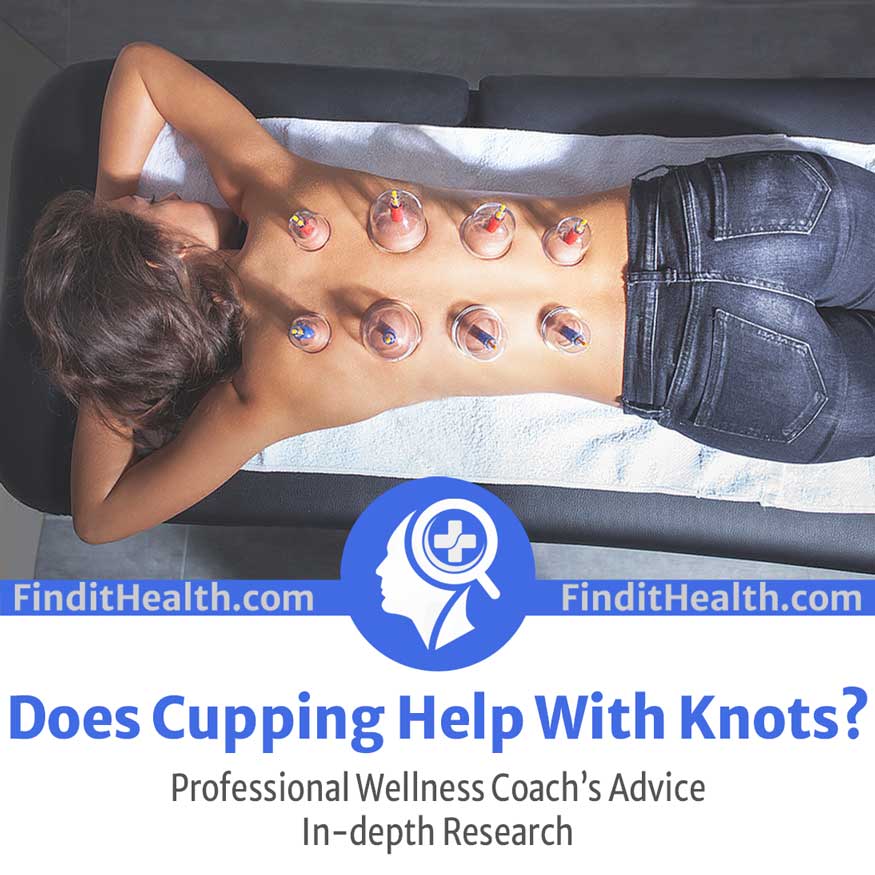
As the director of the health and wellness team here at Find It Health, I would like to present evidence-based research on how cupping helps with knots.
People who experience knots turn to alternative medical practices like cupping to treat them. But does cupping really help with knots?
In this article, put together after comprehensive research by the health and wellness team here at Find It Health, I will explore and provide insights on how cupping helps with knots and other related benefits.
Does Cupping Help With Knots?
According to our research, it does. In cupping, the negative pressure (suction) created by the cups helps lift and stretch the skin and its underlying tissues. This process can help break up knots in the body’s muscles, which helps to reduce the symptoms or heal the patient properly.
Common Symptoms of Knots
These common symptoms include;
- Stiffness from tight muscles
- Weakness
- Soreness
- Tingling
- Numbness
- Pain
- Headaches
- Limited mobility
Symptoms may vary in each individual, depending on the severity of the knots.
However, they should not be taken lightly because this can lead to consequences that may disrupt daily activities in a person’s life.
Knots can disrupt sleep and cause pain that may make it difficult for someone to go about their daily activities.
Consult a healthcare professional or licensed massage therapist to properly diagnose you and offer treatment.
SUBSCRIBE for FREE STRESS MANAGEMENT TECHNIQUES from our EXPERT COACHES!
How Does Cupping Get Rid of Knots?
As a Chinese medicine, cupping therapy helps get rid of knots by increasing blood flow to affected areas in the body where muscles have been twisted or tangled.
When the cups are placed over the affected area, like the back, neck, or legs, the vacuum pulls the skin into the cup, which gently stretches the underlying muscle fibers, creating a space between them.
It gives the sensation of a deep tissue massage.
This space causes better blood circulation or promotes circulation of the lymphatic fluid, which can help alleviate the pain and discomfort associated with knots.
Wet cupping, which is a type of cupping therapy where incisions are made on the skin to draw out toxins and metabolic waste trapped in the blood and muscle tissues, can reduce inflammation and promote better blood circulation, which can effectively heal knots as much as regulate blood pressure.
Explaining Muscle Adhesion Vs Knots
While muscle adhesions and knots are both conditions that affect muscle tissue, they are not the same thing.
Muscle adhesion typically develops after an injury or overuse.
Common signs include soreness and stiffness due to tightness and contraction in the fascia.
But a knot, also referred to as a trigger point, is not actually a knot. Knots occur when the muscles contract or bunch together even when they are not being actively used. Tightness in the affected area or bruises and lumps indicate knots in the body. Knots can also develop as a result of overuse, stress, pain, and injury.
The tense muscle fibers can cause pain in other parts of the body when touched. This is why headaches are a symptom of knots. This happens when the neck and shoulder areas are affected. The back is another common area of the body where knots can occur.
Both muscle adhesions and knots can be treated with the same medical treatments or alternative therapy practices like cupping, acupuncture, and massage.
Stretching and foam rolling can also help address these conditions.
Individuals who want to treat knots or muscle adhesions naturally should consult a licensed therapist, in this case, a cupping professional, and get a proper diagnosis. All types of cupping can be effective in treating these conditions, but depending on the severity and affected areas, they may require longer sessions.
Alternative health practices like cupping are more effective in treating both conditions. This is because the practice involves direct contact with the affected areas and can help reduce the symptoms or heal the individual. If you think a natural treatment isn’t the right choice for you, please consult your healthcare provider for more information.
SUBSCRIBE for FREE STRESS MANAGEMENT TECHNIQUES from our EXPERT COACHES!
Why Do Muscles Knot Up?
Muscles knot up due to stress, poor posture, overuse, or muscle injury. Other reasons why muscles knot up are;
- Emotional stress
- Unhealthy eating habits
- Inactive lifestyle
- Dehydration
- Anxiety
- Physical trauma
- Prolonged bed rest or sitting without stretching
Muscle knots can cause great pain and aching sensations in the muscles and joints. When often touched, they may feel lumpy or swollen. Even when you try to relax, the muscle fibers feel tight and contracted.
When offering treatment, a licensed cupping therapist may tell their patient to change their lifestyles. Not because they want the cupping treatments to work faster but so that the individual will experience overall well-being, as the reasons demonstrated above can also lead to conditions other than muscle knots.
Does Cupping Help with Tight Hamstrings?
Yes, cupping can help with tight hamstrings. Cupping therapy is often effective in relieving tension in the muscles and promoting blood flow and circulation. This act can help release pressure on the hamstring muscles when the suction cups are placed in affected areas around the hamstrings.
How Successful is Cupping for Knots?
From the information provided and according to clinical studies, cupping has been said to provide knots relief in the following ways:
- Relaxing and sedating effect: When cupping is performed along the spine, it stimulates the parasympathetic nervous system, which produces a relaxing and sedating effect on the recipient.
- Lift and stretch tissues: When the skin is pulled or lifted during cupping, it stretches the skin and its underlying tissues, which help treat muscle knots deep in areas like the shoulder. This can help make the shoulder more mobile and reduce pain in the affected area.
- Increased blood circulation: Cupping increases blood circulation to affected areas where the suction cups are placed. This helps relieve muscle tension, which helps improve blood flow and promote healing.
- Form new connective tissues: Cupping helps form new connective tissues and blood vessels, which help promote the healing of injured ones that cause knots.
This effectiveness of cupping can successfully treat knots in the recipient and promote healing. While the treatment may be successful, it does not mean that the condition will be prevented in the future.
During and after cupping treatment, it is best advised to live a life where you can avoid actions that may manifest the condition a second time. An active lifestyle, one or two sessions of alternative therapy like cupping and massage therapy, and good posture are a few good ways to prevent knots.
SUBSCRIBE for FREE STRESS MANAGEMENT TECHNIQUES from our EXPERT COACHES!
Cupping Therapy Most Effective in Treating Knots
All kinds of cupping therapy may be effective in treating knots, but these three are the most effective. Here is how they effectively help in treating knots.
Wet Cupping: The suction of blood, which promotes the release of toxins and metabolic waste from the tissues and blood, promotes blood circulation, and reduces inflammation in the body which is very necessary when treating knots.
Dry Cupping: When the cups are placed on the skin and create a vacuum that pulls and stretches the skin and tissues, blood and lymphatic flow is encouraged. This helps to relieve tension in the muscles and aids in alleviating knots.
Moving Cupping: The massage-like effect of moving cupping, which involves the use of silicone cups and oil to move over affected areas in the back and legs, can help be effective in treating knots when the moving effect breaks uptightness and adhesions in the muscles.
FindItHealth.com – Frequently Asked Questions
Does cupping help with knots?
Yes, cupping helps with knots. The suction created by the cups can stretch and elongate the muscle fibers, which can help to break up adhesions and knots.
How does cupping get rid of knots?
Cupping gets rid of knots when blood flow or circulation is promoted in the affected areas. This helps promote muscle and pain relief which can help the muscles to help properly.
Does cupping help muscle knots?
Yes, cupping helps muscle knots. Cupping stretches and elongates the muscle fibers, which can help break up the tightness and relieve pain in the affected areas.
Does cupping loosen knots?
Yes, cupping helps loosen knots when the suction effect created by cupping loosens and elongates the muscle fibers, relieving pressure and tension in affected areas that are tight.
SUBSCRIBE for FREE STRESS MANAGEMENT TECHNIQUES from our EXPERT COACHES!
Conclusion
Alongside other forms of alternative medical practices like moxibustion, acupuncture, and massage therapy, cupping therapy is fast becoming an effective method in treating conditions like knots.
The benefits of cupping therapy vary and can range from blood circulation, reduced inflammation, muscle relief, and proper digestion to improved mobility, pain relief, and flushing out toxins from the body, which can all promote the effective healing of knots in a person.
It is best to consult with the cupping practitioner before you proceed with treatment, so a suitable cupping treatment will be recommended for you.
Keep in mind that treatment may require longer sessions, for months, and may take time to properly heal, depending on factors like the severity of the knots and the affected areas.
Changes to your lifestyle will increase progress and reduce your chances of getting knots again. Listen to your healthcare provider or cupping therapist when these changes are advised.
SUBSCRIBE for FREE STRESS MANAGEMENT TECHNIQUES from our EXPERT COACHES!

